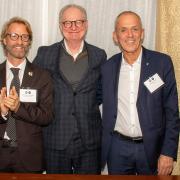On April 13, Fermi National Accelerator Laboratory celebrated three important construction milestones designed to increase the lab’s research efficiencies and capabilities and continue progress on the international Deep Underground Neutrino Experiment.
Two new buildings opened on the campus: a new 80,000-square foot Integrated Engineering Research Center and a cryogenic plant. Ground was also broken for a complex that will house the 705-foot-long linear accelerator for DUNE, a massive experiment to understand the neutrino—one of the most elusive and mysterious subatomic particles in the universe.
The Building Fermilab’s Future ceremony was held in Batavia, Illinois, at the main campus of Fermilab, which is affiliated with the University of Chicago.
In attendance were representatives from the U.S. Department of Energy Office of Science; Illinois Gov. J.B. Pritzker and local officials, including U.S. Reps. Sean Casten and Bill Foster; University of Chicago President Paul Alivisatos and Executive Vice President for Science, Innovation, National Laboratories, and Global Initiatives Juan de Pablo; and national and international partners and collaborators.
“We don’t know that we’re witnessing history until, frankly, it is in the rear-view mirror. But with Fermilab, we get to celebrate discovery and innovation in real time, right now,” said Gov. J.B. Pritzker.
The DUNE experiment will send trillions of neutrinos 800 miles through the earth from Illinois to an underground facility in South Dakota, with no tunnel required, and study them when they interact in detectors on both ends of that journey.
Fermilab Director Lia Merminga welcomed all who attended, calling it “major steps toward transforming our lab’s physical and scientific/engineering landscape.”
“The new IERC and the PIP-II Cryoplant buildings will be centers of excellence for research, innovation and collaboration that will accelerate the science of DUNE and a rich array of discoveries,” she said.
"The University is proud to be working with our partner universities, the Department of Energy, and the Fermilab community of scientists, engineers, and staff as ground is being broken on a new generation of tools that will lead to major new physics discoveries in the coming years," said UChicago President Paul Alivisatos.
The three new projects are:
- The brand-new, 80,000-square-foot Integrated Engineering Research Center, located next to the iconic Wilson Hall, will provide state-of-the-art lab space, making research and development a more collaborative and centralized process. It will be the new home of engineers and technicians working on high-energy physics projects, like the international Deep Underground Neutrino Experiment led by Fermilab and the proposed next-generation cosmic microwave background project called CMB-S4. It will also enable cutting-edge engineering for emerging technologies, including quantum and microelectronics.
- The new PIP-II Cryogenic Plant Building was also opened at the event. It will house a cryogenic plant, which is an in-kind contribution from the Department of Atomic Energy, India, to provide the PIP-II accelerator with liquid helium to cool superconducting radio-frequency modules for particle acceleration. PIP-II is an essential enhancement to the Fermilab particle accelerator complex that will power beamline-based experiments at Fermilab. Its new 215-meter linear accelerator, or linac, will eventually power the high-energy neutrino beam that will send neutrinos through the earth toward the international DUNE project in Lead, South Dakota. PIP-II is the first U.S. accelerator project to be built with significant international contributions.
- The groundbreaking for the Linac Complex for the PIP-II accelerator kicks off the construction of the approximately 800,000-square-foot complex that will have four components: the linac tunnel, where the linear accelerator will reside; the linac gallery that will house equipment, much of which will come from international partners as in-kind contributions; the high bay building, where the loading dock and room-temperature front end of the linac will be located; and a beam transfer line. The entire construction project is expected to take approximately 39 months.
Fermilab is located on 6,800 acres of prairie land in Batavia, Illinois, a Chicago suburb. The area selected for the PIP-II site minimizes the impact on the prairie, which Fermilab maintains.
Funding: The construction of the Integrated Engineering Research Center was funded by the Science Laboratory Infrastructure program within the Department of Energy Office of Science.
- Adapted from an article first published by Fermilab.

